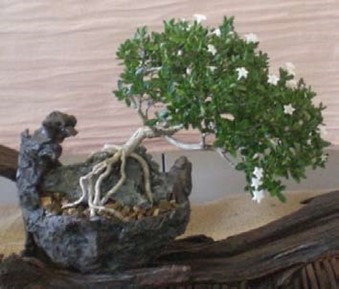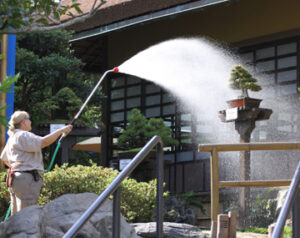
Type: Subtropical evergreen that is native to southern China and southeast Asia. Grown as an indoor bonsai in temperate parts of the world.
These small shrubs are much loved as bonsai for their tiny flowers which may occur 2-3 times yearly, gnarled trunks, and naturally miniature leaves. Most bonsai are S. foetida, of which many cultivars are available.
Serissa is a notoriously fussy bonsai. The good news is that they aren’t that hard to keep alive. But considering that most people buy Serissa on impulse because the plant is so spectacular at the store, the bad news is bad indeed. The plant will generally drop its flowers within a day or two. Then the plant will drop its leaves. If the grower doesn’t panic (and many Serissas are inadvertently killed by panicking beginners who respond by drastically over/ under watering the plant) the plant will soon re-grow its leaves. A power struggle then ensues. The grower soon discovers that the Serissa drops its leaves if it has too much water. Too little water.
If it’s too hot or too cold. If it’s moved, or there is a shift in lighting or temperature. (BCI)
Style: Suitable for any style except formal upright and broom. (Tomlinson, 103)
Summer Placement: Keep out of full sun in summer. Put in bright window that is shaded from strong direct sunlight.
Winter Placement: In winter place in window that maintains a temperature of 54-64 F. (Lesniewicz, 85)
Watering: Requires a lot of water in summer. In winter keep moist but not wet. Put on a humidity tray in winter and mist foliage daily. Do not leave in standing water as root rot will occur.
Feeding: Every two weeks in spring and summer. Every four to six weeks in fall and winter.
Wiring: Can be wired at any time.
Pruning: Can be pruned throughout the year. Trim to one or two leaf pairs after several pairs of leaves form. To promote more flowering, once a flower withers pinch it out. (Lesniewicz) Repotting Season: March-April every second year along with a light root pruning. When the roots are cut you will notice a foul smell, which explains its Latin name “foetida”, which means stinking. (Lesniewicz)
Soil Mix: Loam, sand and peat in equal parts.
Container: Looks good in ornate glazed Chinese pots.
James Keith



